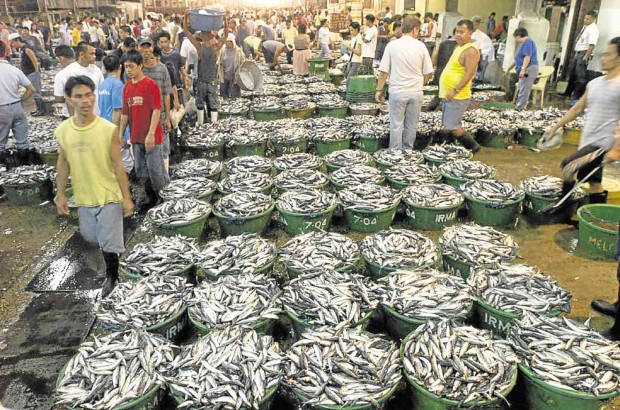Ban on ‘galunggong’ fishing in Palawan lifted

TUBS of “galunggong” (round scad), the so-called poor man’s fish, are unloaded at the Navotas fish port, ready for distribution to major markets in Luzon. JOAN BONDOC
PUERTO PRINCESA CITY—Expect more of the poor man’s fish on the table as the Bureau of Fisheries and Aquatic Resources (BFAR) lifted on Monday a three-month ban on commercial catching of “galunggong” (round scad) in northern Palawan.
BFAR’s move raised industry expectations of a more robust production and supply from the country’s largest and most productive fishing ground for galunggong.
“We are pleased with the compliance of commercial fishing operators and we are hoping this will improve the production of Palawan,” BFAR Director Asis Perez said in a briefing.
BFAR has targeted Palawan’s northwestern area, which traditionally supplies 70 to 80 percent of round scad delivered to the Navotas fish port, which serves the entire Luzon market.
The ban has covered only commercial fishers and was implemented in Palawan for the first time. BFAR has been conducting a similar practice in the last four years, mainly in the Visayas and Mindanao.
BFAR began the ban for Palawan in November last year, prompted by marine studies from 2002 to 2004 showing a 40-percent decline in the province’s catch that is monitored in Navotas. Annual galunggong production during that period reached a peak of about 88 metric tons and dropped to a low of 38 metric tons.
“In the Zamboanga peninsula, we saw a 30-percent increase in catch because of the closed season,” said Edgar Lim of Permex, a firm producing and exporting canned sardines.
Lim said the impact of the closed fishing season in Palawan was significant because of the importance of the province’s fishing grounds to the country’s fishing industry.
“We call this area the Cuyo basin. It’s the biggest shallow water area in the country, which is why it is very productive for galunggong,” he said.
Perez said they expected an increase in fish biomass in areas covered by the ban. With productivity anticipated to increase, he said they see lower prices for galunggong in the market.
“Our target is to bring down the price of galunggong to around P70 to P80 a kilogram in the markets,” Perez said.














